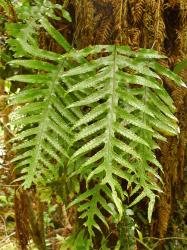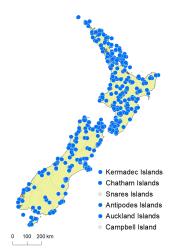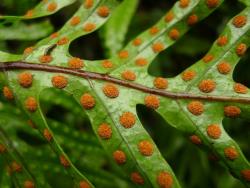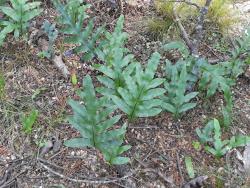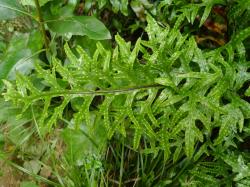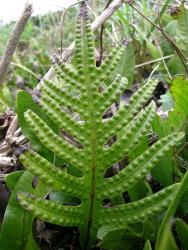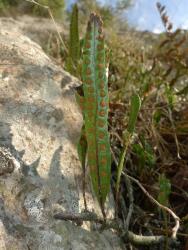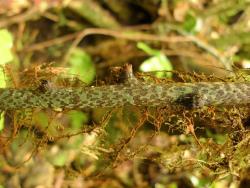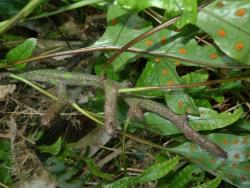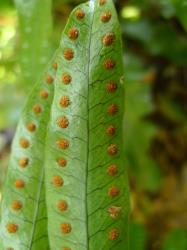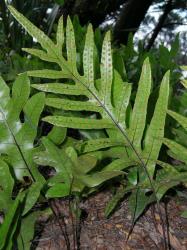- = Zealandia pustulata (G.Forst.) Testo & A.R.Field, Syst. Bot. 44: 750 (2019) subsp. pustulata
Epiphytic and terrestrial; creeping or climbing ferns. Rhizomes long-creeping, 3–11 mm diameter, scaly. Rhizome scales clathrate, ovate, 3–7 mm long, 1–2 mm wide, mostly appressed but with the tips sometimes squarrose, blackish-brown, entire. Roots of one type, lacking laterally inserted and clasping roots. Fronds 45–750 mm long. Stipes 10–350 mm long, pale to chocolate brown, glabrous or with very scattered scales. Laminae very varied, from undivided or variously lobed to deeply 1‑pinnatifid; undivided laminae (fertile) narrowly elliptic, 35–220 mm long, 6–30 mm wide, or (sterile) longer and broader, up to 260 mm long and 70 mm wide; lobed or pinnatifid laminae (fertile) ovate to elliptic or broadly ovate to broadly elliptic, 50–425 mm long, 35–350 mm wide, or (sterile) up to 420 mm long and 300 mm wide; lamina alate for 5–40 mm below the lowest lobe, bright glossy green, coriaceous, glabrous or with scattered scales on the costae, especially on young fronds. Lamina lobes (fertile) in 1–15 pairs, 25–185 mm long, 4–30 mm wide, or (sterile) less numerous and wider, in up to 10 pairs and up to 60 mm wide; straight, acute to acuminate, margins entire or wavy, widest about the middle. Veins reticulate, forming 2–3 series of areoles between costa and margin; hydathodes conspicuous on adaxial surface of lamina. Sori round or rarely elliptic, 2.5–5 mm wide, impressed into lamina forming low bulges on adaxial surface, in 1 row either side of costa, medial or closer to the margin; paraphyses absent; exindusiate.
This is the commonest and most variable of the three species of Lecanopteris in New Zealand. It can be distinguished by its thick rhizomes (>4 mm diameter) with appressed blackish-brown scales, its very variable fronds (Brownsey & Smith-Dodsworth 2000, fig. 63), coriaceous and bright glossy green laminae, conspicuous veins and hydathodes on the upper lamina surface, and broad lamina lobes.
Occasional aberrant forms are found, either crested at the apices or with 2-pinnatifid laminae.
Only one subspecies is present in New Zealand. Lecanopteris pustulata subsp. howensis (Tindale et P.S.Green) Perrie & Brownsey is recognised as endemic to Lord Howe Island (Bostock & Spokes 1998 – as Microsorum). It is distinguished by having rhizome scales that are abruptly acuminate and 1.5–3.3 mm wide, laminae that are usually divided to the rachis into adnate pinnae, and sori that are deeply sunken into the lamina and usually either submarginal or about one-third of the way to the costa.
North Island: Northland, Auckland, Volcanic Plateau, Gisborne, Taranaki, Southern North Island.
South Island: Western Nelson, Sounds-Nelson, Marlborough, Westland, Canterbury, Otago, Southland, Fiordland.
Kermadec Islands, Three Kings Islands, Chatham Islands, Solander Island, Stewart Island, Antipodes Islands, Auckland Islands.
Altitudinal range: 0–1050 m.
Lecanopteris pustulata is abundant throughout the North Island from near sea level, growing to over 1050 m on Mt Hauhungatahi near Erua, and in the north-west Ruahine Range. It is common in coastal and lowland regions of the South Island, extending locally to over 900 m at Jordan Stream Reserve, Marlborough, near Mt Cook, and in the Edith Valley, Fiordland, but it is largely absent from inland high country regions and much of Otago.
Also Australia (Queensland, NSW, ACT, Victoria, Tasmania), Norfolk Island.
Lecanopteris pustulata is found creeping, and often covering extensive areas, on the ground, growing over rocks or fallen logs, on cliffs and banks, or epiphytic on native and naturalised trees. It occurs in coastal to montane forest, pine forest, scrub, scoria and open areas, usually in slightly drier habitats, extending into subalpine scrub in the southern South Island.
n = 37 (Brownlie 1954, as Microsorium diversifolium).
This species has been widely known as Phymatosorus diversifolius (e.g. Brownsey & Smith-Dodsworth 1989), Microsorum diversifolium (e.g. Crookes 1963) or Phymatodes diversifolium (e.g. Allan 1961), with these combinations being based on Polypodium diversifolium Willd. collected in Tasmania by Labillardière. An earlier basionym, Polypodium pustulatum G.Forst., was for many years considered a “species dubia” because of the inadequate type specimen lacking a rhizome, which could not be distinguished as either diversifolium or novae-zealandiae (Pichi Sermolli 1951). However, on the basis of spore morphology, Large et al. (1992b) showed conclusively that the specimen is the same as the former, and that Forster’s name, P. pustulatum, should take priority. The species was initially treated as Microsorum pustulatum by Large et al. (1992b), then as Phymatosorus pustulatus (Large et al. 1992a), and more recently as Zealandia pustulata (Testo et al. 2019).
Robert Brown’s Polypodium billardierei, and names based on his type from Port Dalrymple, are later synonyms. The name Polypodium phymatodes L. used by Richard (1832) is a misidentification.



